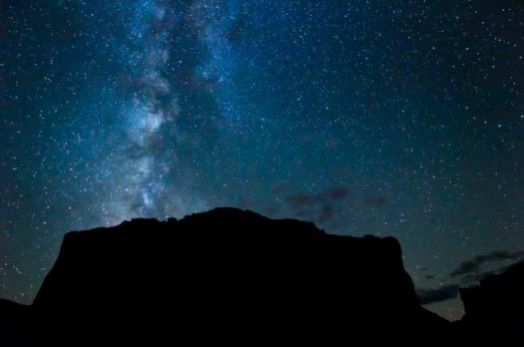[dt_button link=”http://d165vjqq8ey7jy.cloudfront.net/mp3/27311/se-7964s.mp3″ target_blank=”true” button_alignment=”default” animation=”fadeIn” size=”small” style=”default” bg_color_style=”custom” bg_color=”#333333″ bg_hover_color_style=”custom” bg_hover_color=”#444444″ text_color_style=”custom” text_color=”#ffffff” text_hover_color_style=”custom” text_hover_color=”#dddddd” icon=”fa fa-cloud-download” icon_align=”left”]Yuklash[/dt_button]
[dt_divider style=”thin” /]
Transcript:
Voice 1
Welcome to Spotlight. I’m Luke Haley.
Voice 2
And I’m Liz Waid. Spotlight uses a special English method of broadcasting. It is easier for people to understand, no matter where in the world they live.
Voice 1
If you walk outside in the middle of the night what do you see in the sky? You probably see stars. If you live in the country, you can see many stars. But if you live in a city, you may notice only a few. This difference is important. What happened to all the stars?
Voice 2
The stars are still in the sky. But people cannot see them because of light pollution. Too much light can make it difficult to see the night sky. But light pollution affects more than just the night sky. It affects all life on earth. Some scientists warn that light pollution damages people and animals. These scientists are working to save the night sky. Today’s Spotlight is on light pollution and the disappearing night sky.
Voice 1
Thousands of years ago, it was common to see many stars in the sky. That was because there were no lamps or electric lights. People who wanted light needed to build a fire. However, this changed with the invention of electricity. More and more people could buy electric, or artificial, lights. They could put the artificial lights in their houses, businesses and streets. Bob Parks works for the International Dark-Sky Association. This organization works to keep and protect the night time environment. He told the Diane Rehm Show:
Voice 3
“Over the past 50 years the population has moved closer to cities. Cities have gone brighter, using more lights. And that means that most people growing up today will never see beautiful groups of stars. They will never see a natural night sky. They will never be inspired by it. And we think that is very tragic.”
Voice 2
Today, people are surrounded by light – even at night time. Much of this light is not necessary. Or the light travels where it should not be – it creates light pollution. Light pollution is any artificial light that goes where it is not supposed to be. For example, a person can put a light on the outside of his house. It shines on his own house. But the light could be too strong. It may also shine on his neighbor’s house. The extra light shining on the neighbor’s house is one kind of light pollution.
Voice 1
Other light pollution can come from cities. Have you ever travelled to a big city at night? You may have noticed that the big city looks like it is glowing. It has a low, soft, light all around it. Pictures from space show the soft lights of cities from all over the world.
Voice 2
But is all this light really a big problem? People need light to see. They need light to work and drive safely at night, and for many other things! But scientists say that this extra light has proven effects on living creatures – animals and humans.
Voice 1
One animal affected by light pollution is the sea turtle. Pregnant sea turtles always lay their eggs on a dark beach. The beach is near the water, but covered in sand. The turtle digs a hole in the sand and lays her eggs. When the baby sea turtles are born, they climb out of their eggs. Bob Parks describes how these baby sea turtles, or hatchlings, are affected by light pollution.
Voice 3
“For thousands of years, sea turtle hatchlings, when they come out, have moved toward the brightest light source in the sky. That has been the stars over the water. That gets them into the water safely when they hatch at night. If you have lights from buildings behind the beach, when the hatchlings come out, they are drawn to the brightest light source. That is often a car parking lot or a road. The hatchlings never make it back to the water.”
Voice 2
Today sea turtles are finding fewer and fewer dark beaches. But people like Bob Parks work to fix this situation. Parks works with the government. This part of the government works to manage and protect animals. Together, they redesign public lighting – like the lights in car parking lots and roads. They use less intense lights. Public lights are usually a blue color, similar to stars. So instead they use a light that is a little different in color. The hatchlings do not go toward the yellow, orange or red lights.
Voice 1
Birds experience problems because of light pollution too. Many birds travel to a different area of the world to mate and lay eggs. They often travel at night. But lights from tall buildings can lead the birds off their natural path. A bird may use all its energy flying the wrong way. It may be too tired to continue its natural path. Birds may also crash into brightly lighted buildings. They may die.
Voice 2
Light pollution also has proven effects on humans. Hormones are chemicals in people’s bodies. They help the body to grow and develop. Light influences these hormones. One of these hormones is called melatonin. Melatonin governs when people sleep and wake. Light can suppress melatonin. Yet many people go to bed with the lights on. This suppresses melatonin. These people do not sleep well. Some people also work in the middle of the night. They work in artificial light. Then they sleep during the day. Experts say that this also has bad effects on a person’s hormones – especially melatonin.
Voice 1
Some studies show that when people continually suppress their melatonin, they have higher rates of health problems. People can reduce these risks in simple ways. First, do not go to bed with the light on. And second, if you work in the middle of the night, try to work at similar times for a few weeks. Do not work some nights and some days. Instead, form a pattern.
Voice 2
People and animals need light. But they also need darkness. There are simple ways to solve the problem of light pollution. Experts say that people must first use light wisely. Only use the amount of light that you need. Do not think that more light is better light.
Voice 1
People also can greatly reduce light pollution by using well-designed lights. These lights use particular colors. They only shine light where it should be. Using less light and better lighting methods reduces the energy people use.


